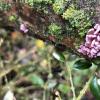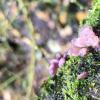
28-10-2025 19:33
 Nicolas Suberbielle
Nicolas Suberbielle
Bonjour à tous,Je voudrais votre avis sur cette r

31-10-2025 09:19
 Lothar Krieglsteiner
Lothar Krieglsteiner
Can somebody provide me with a file of:Rogerson CT

09-08-2025 13:13
 Maria Plekkenpol
Maria Plekkenpol
Hello,Yesterday I found these on burnt soil. Apoth

25-11-2016 13:54
 Stephen Martin Mifsud
Stephen Martin Mifsud
Hi, I found numerous seeds of Washingtonia robusta

28-10-2025 22:22
 Bernard Declercq
Bernard Declercq
Hello.I'm searching for the following paper:Punith

28-10-2025 15:37
Carl FarmerI'd be grateful for any suggestions for this strik
I have read that microscopy is better to distinguish the apothecia from A. cylinchnium. Is this the only similar species to consider, and is the brain-like anamorph only formed by A. sarcoides?
I include some photos from southern England, last year (20/11/2023), showing both morphs together on the fallen trunk of an unindentified angiosperm, possibly Betula, in mixed deciduous woodland.
Thanks in advance.

Thank you for answering, it seems the third traditional species you referred to must be A. albida (solitaria).
I do have another collection from the same day, a few minutes walk up a nearby stream. This was a solitary, small, purplish apothecium, on very damp and decayed wood that I suspect is Fraxinus excelsior.
I thought this may be an A. sp. too, although the habitat and habit seems a little different. I still have the dried apothecium but I haven't worked with dry material before and I guess it will be harder.







